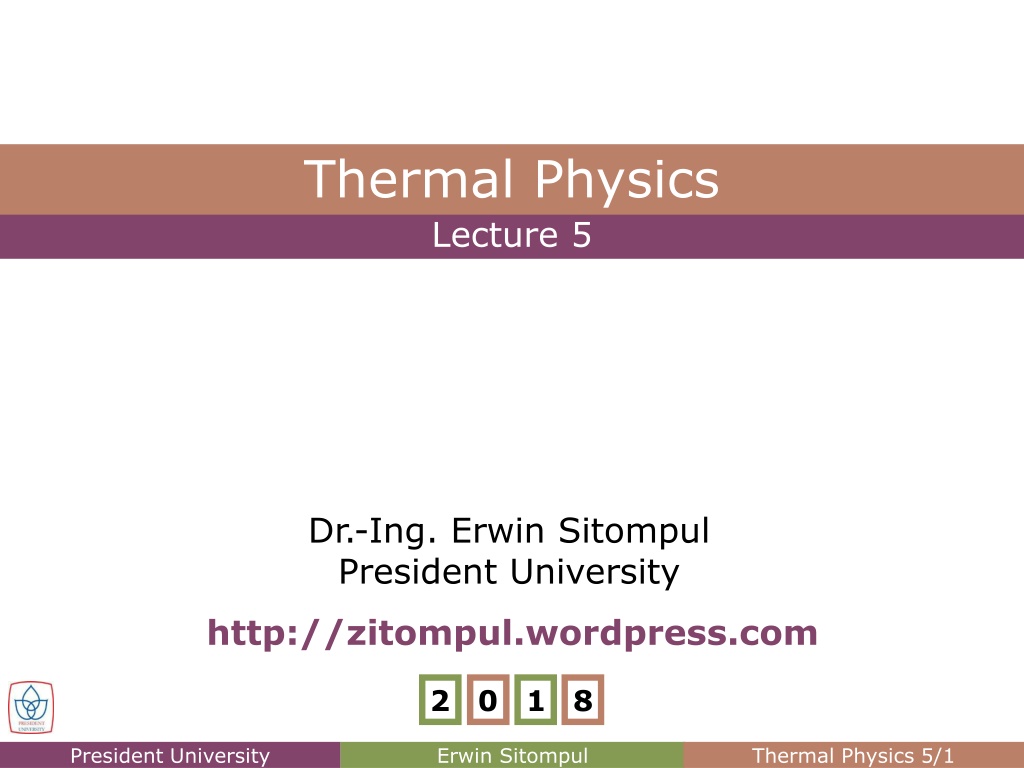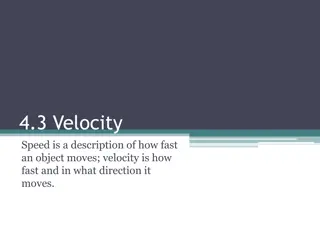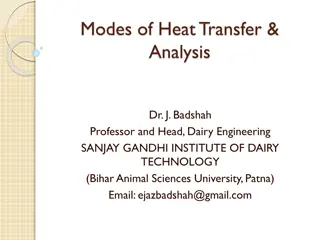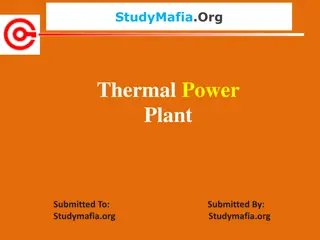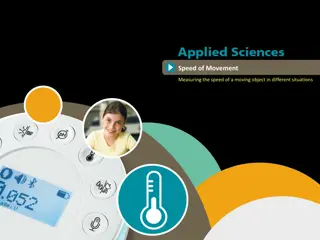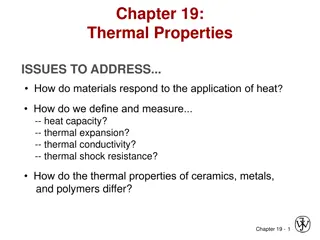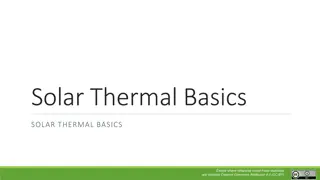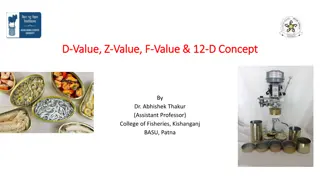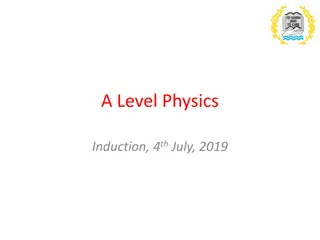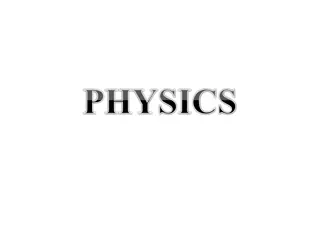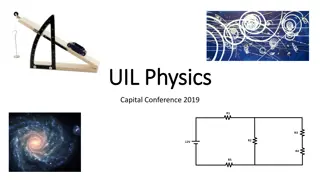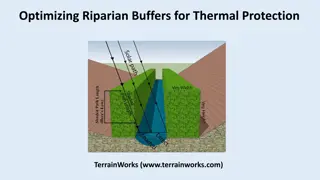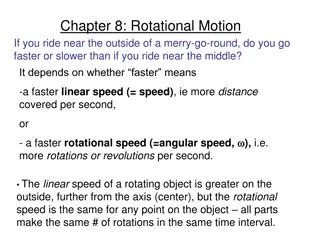Molecular Speed Distribution in Thermal Physics
Exploring the distribution of molecular speeds in gases at different temperatures through the Maxwell-Boltzmann speed distribution law. This lecture covers the concepts of probability distribution functions for speed intervals, comparison of speed distributions at varying temperatures, and calculations for average, root-mean-square (RMS), and most probable speeds of gas molecules.
Download Presentation

Please find below an Image/Link to download the presentation.
The content on the website is provided AS IS for your information and personal use only. It may not be sold, licensed, or shared on other websites without obtaining consent from the author.If you encounter any issues during the download, it is possible that the publisher has removed the file from their server.
You are allowed to download the files provided on this website for personal or commercial use, subject to the condition that they are used lawfully. All files are the property of their respective owners.
The content on the website is provided AS IS for your information and personal use only. It may not be sold, licensed, or shared on other websites without obtaining consent from the author.
E N D
Presentation Transcript
Thermal Physics Lecture 5 Dr.-Ing. Erwin Sitompul President University http://zitompul.wordpress.com 2 0 1 8 President University Erwin Sitompul Thermal Physics 5/1
Chapter 19 Kinetic Theory The Distribution of Molecular Speeds The root-mean-square speed vrms gives us a general idea of molecular speeds in a gas at a given temperature. But, we often want to know more about how the possible values of speed are distributed among the molecules. The speed distribution for oxygen molecules at room temperature (T = 300 K) is shown below. President University Erwin Sitompul Thermal Physics 5/2
Chapter 19 Kinetic Theory The Distribution of Molecular Speeds In 1852, Scottish physicist James Clerk Maxwell first solved the problem if finding the speed distribution of gas molecules. The resulting Maxwell s speed distribution law can be written as: 3 2 2 2 ( ) 4 2 RT M R T v M 2 = Mv RT P v v e : molar mass of the gas : gas constant : gas temperature : molecular speed The quantity P(v) is a probability distribution function. For any speed v, the product P(v)dv (an area, dimensionless) is the fraction of molecules with speed in the interval dv centered on speed v. President University Erwin Sitompul Thermal Physics 5/3
Chapter 19 Kinetic Theory The Distribution of Molecular Speeds As shown in the figure, the fraction of molecules with speeds in the interval dv is equal to the area of a strip with height P(v) and width dv. The total area under the distribution curve corresponds to the fraction of the molecules whose speeds lie between zero and infinity. Since all molecules fall into this category, the value of this total area is unity: = ( ) 1 P v dv 0 The fraction (frac) of molecules with speeds in an interval of v1 and v2 is then: frac = v 2 ( ) P v dv v 1 President University Erwin Sitompul Thermal Physics 5/4
Chapter 19 Kinetic Theory The Distribution of Molecular Speeds As the speed is a function of temperature, the speed distribution also varies with temperature. The distribution at T = 300 K is compared with the one at T = 80 K in the following figure. President University Erwin Sitompul Thermal Physics 5/5
Chapter 19 Kinetic Theory Average, RMS, and Most Probable Speeds In principle, we can find the average speed vavg of the molecules in a gas by evaluating: = ( ) v vP v dv avg 0 After substituting P(v) and performing the integral, 8RT v M = Average Speed avg Similarly, we can find the average of the square of the speeds v2avg with 2 2 avg 0 After substituting P(v) and performing the integral, 3RT v M = ( ) v v P v dv = 2 avg President University Erwin Sitompul Thermal Physics 5/6
Chapter 19 Kinetic Theory Average, RMS, and Most Probable Speeds Thus, 3RT v M = RMS Speed rms The most probable speed vP is the speed at which P(v) is maximum. To calculate vP, we set dP/dv=0 and then solve for v. Doing so, we find: 2 P v M RT = Most Probable Speed A molecule is more likely to have speed vP than any other speed, but some molecules will have speeds that are many times vP. These molecules lie in the high-speed tail of a distribution curve. President University Erwin Sitompul Thermal Physics 5/7
Chapter 19 Kinetic Theory Problem A container is filled with oxygen gas maintained at room temperature (300 K). What fraction of the molecules have speeds in the interval 599 to 601 m/s? The molar mass M of oxygen is 0.0320 kg/mol. The interval v = 2 m/s is very small compared to the center speed v=600 m/s. Thus the integration can be approximated through: 3 2 M 2 = 2 2 Mv RT frac 4 v e v 2 RT 3 2 0.0320 ( ) 2 = (601 599) (0.0320)(600) 2(8.31)(300) 2 4 (600) e 2 (8.31)(300) 2.31 = (1.321 10 )( ) (2) 2 e 2.622 10 = 3 = 0.2622% President University Erwin Sitompul Thermal Physics 5/8
Chapter 19 Kinetic Theory The Molar Specific Heats of an Ideal Gas In this section, we want to derive an expression for the internal energy Eint of an ideal gas from molecular consideration. In other words, we want an expression for the energy associated with the random motions of the atoms or molecules in the gas. We shall then use that expression to derive the molar specific heats of an ideal gas. President University Erwin Sitompul Thermal Physics 5/9
Chapter 19 Kinetic Theory The Molar Specific Heats of an Ideal Gas Internal Energy Eint Let us first assume that the ideal gas is a monatomic gas such as helium, neon, or argon. The internal energy Eint of the ideal gas is simply the sum of the translational kinetic energies of its atoms. The average translational kinetic energy of a single atom depends only on the gas temperature and is given as Kavg =3/2 kT. A sample of n moles of such a gas contains nNA atoms. The internal energy of the sample is then: ( ) ( )( E nN K nN kT = = ) 3 2 int A avg A Since k = R/NA, we can rewrite this as: 3 int 2 E nRT = Monatomic Ideal Gas The internal energy Eint of an ideal gas is a function of the gas temperature only. President University Erwin Sitompul Thermal Physics 5/10
Chapter 19 Kinetic Theory The Molar Specific Heats of an Ideal Gas Molar Specific Heat at Constant Volume The figure on the right shows n moles of an ideal gas at pressure p and temperature T, confined to a cylinder of fixed volume V. This initial state is denoted as i. Suppose a small amount of energy to the gas as heat Q is added to the gas. The gas temperature rises a small amount T+ T, and its pressure rises to p+ p. This final state is denoted as f. We would find that the heat Q is related to the temperature change T by: Q nC T = Constant Volume V CV is a constant called the molar specific heat at constant volume [J/mol K]. President University Erwin Sitompul Thermal Physics 5/11
Chapter 19 Kinetic Theory The Molar Specific Heats of an Ideal Gas The first law of thermodynamics can now be written as: E nC T W = int V With the volume held constant, the gas cannot do any work, W=0. This yields: E C n T n T 3 2nR T = = int V Thus, = = 12.5 J mol K C R 3 2 Monatomic Gas V We can now generalize the equation for the internal energy as: E nC T = Any Ideal Gas int V President University Erwin Sitompul Thermal Physics 5/12
Chapter 19 Kinetic Theory The Molar Specific Heats of an Ideal Gas When an ideal gas that is confined to a container undergoes a temperature change T, then we can write the resulting change in its internal energy as: = E nC T Any Ideal Gas, Any Process int V The change in the internal energy Eint of a confined ideal gas depends on the change in the gas temperature only. It does not depend on what type of process produces the change in the temperature. President University Erwin Sitompul Thermal Physics 5/13
Chapter 19 Kinetic Theory The Molar Specific Heats of an Ideal Gas Molar Specific Heat at Constant Pressure We now assume that the temperature of our ideal gas is increased by the same small amount T as previously but now the necessary energy (heat Q) is added with the gas under constant pressure. From such experiments we find that the heat Q is related to the temperature change T by: = Q nC T Constant Pressure P CP is a constant called the molar specific heat at constant pressure [J/mol K]. CP> CV, because energy must now be supplied not only to raise the temperature of the gas but also for the gas to do work. President University Erwin Sitompul Thermal Physics 5/14
Chapter 19 Kinetic Theory The Molar Specific Heats of an Ideal Gas To relate the molar specific heats CP and CV, we start with the first law of thermodynamics: E Q W = = int T nC nC T nR T V P We will find that: C = = + C R V P C C R P V President University Erwin Sitompul Thermal Physics 5/15
Chapter 19 Kinetic Theory The Molar Specific Heats of an Ideal Gas President University Erwin Sitompul Thermal Physics 5/16
Chapter 19 Kinetic Theory The Equipartition of Energy The figure shows the ratio Cv/R as a function of temperature for H2 gas: Below 80 K, Cv/R = 3/2, gas behaves as though it is monoatomic. Only translational modes of motion are excited. At 200-300 K, Cv/R = 5/2, rotational modes become excited. At above 3000 K, CV/R = 7/2, vibrational modes become excited. President University Erwin Sitompul Thermal Physics 5/17
Chapter 19 Kinetic Theory Further Problem (a) What is the average translational kinetic energy of a molecule of an ideal gas at a temperature of 27 C ? (b) What is the total random translational kinetic energy of the molecules in 1 mole of this gas? (a) = = 23 = 21 3 2(1.38 10 )(300) K kT 3 2 6.21 10 J avg (b) = = (1)(6.02 10 )(6.21 10 = = 23 21 3738.4 J ) ( ) K E nN K total int avg A President University Erwin Sitompul Thermal Physics 5/18
Chapter 19 Kinetic Theory Checkpoint The figure here shows five paths traversed by a gas on a p-V diagram. Rank the paths according to the change in internal energy of the gas, greatest first. 5, then tie of 1, 2, 3, and 4. = E nC T int V President University Erwin Sitompul Thermal Physics 5/19
Chapter 19 Kinetic Theory Problem A bubble of 5.00 mol of helium is submerged at a certain depth in liquid water when the water (and thus the helium) undergoes a temperature increase T of 20.0 C at constant pressure. As a result, the bubble expands. The helium is monatomic an ideal. (a) How much energy is added to the helium as heat during the increase and expansion? = = = 2077.5J (5)( )(20) R Q nC T 5 2 P (b) What is the change Eint in the internal energy of the helium during the temperature increase? = 2 (5)( )(20) R = = 1246.5 kJ E nC T 3 int V (c) How much work W is done by the helium as it expands against the pressure of the surrounding water during the temperature increase? = = nR T = = 2077.5 1246.5 831kJ W Q E int President University Erwin Sitompul Thermal Physics 5/20
Chapter 19 Kinetic Theory Class Group Assignments 1. The rms velocity of oxygen molecules at 27 C is 318 m/s. Thus, the rms velocity of hydrogen molecules at 127 C is: (a) 1470 m/s (b) 1603 m/s (c) 1869 m/s (d) 2240 m/s (e) 3211 m/s 2. An ideal gas of N monoatomic molecules is in thermal equilibrium with an ideal gas of the same number of diatomic molecules and equilibrium is maintained as the temperature is increased. The ratio of the changes in the internal energies Edia/ Emon is: (a) 1/2 (b) 3/5 (c) 1/1 (d) 5/3 (e) 2/1 3. An ideal gas has molar specific heat CP at constant pressure. When the temperature of n moles is increased by T the increase in the internal energy is: (a) nCP T (d) n(CP+R) T (b) n(CP R) T (e) n(2CP+R) T (c) n(2CP R) T President University Erwin Sitompul Thermal Physics 5/21
Chapter 19 Kinetic Theory No Homework This Week Prepare well for the midterm exam. President University Erwin Sitompul Thermal Physics 5/22
